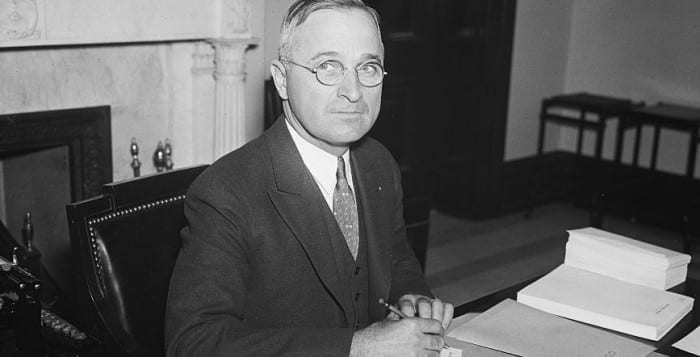By Rich Acritelli
He came from humble beginnings to make one of the most critical but grave decisions in United States history.
Born on May 8, 1884, to a poor Missouri farming family, Harry S. Truman’s roots were far removed from those of Franklin Delano Roosevelt. While he was a capable student, his poor eyesight prevented an appointment to the U.S. Military Academy at West Point. He never attended college, and was expected to help with the family business. But to get away from the boredom of agriculture, he enlisted in the National Guard and, though he would have been exempted from Selective Service, re-enlisted at age 33, when President Woodrow Wilson declared war in April 1917.
At once, Truman’s superiors and peers voted that he become an officer, and the future president was proud to take on the role. His soldiers saw him as an organized and bright leader who took care of his men. After training in Oklahoma, Truman and his artillery battery traveled to New York City, where the Missouri soldiers were some of the first Americans to be transported on the USS George Washington, a confiscated German passenger ship that was used to transport a portion of the 2.5 million Americans who fought on the Western Front. While in New York, Truman was not overly impressed with Manhattan and, in fact, liked Paris better when he visited that city after the World War I armistice.
Once in France, Truman learned how to fire the French 75-mm field gun, the best artillery weapon produced during the conflict. He was promoted to captain and the head of an artillery battery, and proved to be an honest man, speaking objectively to superior officers about the needs of his men. Near the front, Truman trained with Gen. John J. Pershing and led his battery in the 1918 Muesse-Argonne offensive. He was one of the 600,000 soldiers used to punch a hole into the tired lines of the German military. It is possible Truman’s guns fired some of the final shots before the Central Powers surrendered on Nov. 11, 1918.
The interwar years were spotted with success and failure for Truman. Once the war concluded, Truman desperately wanted to marry his Missouri sweetheart, Bess Wallace, and for a brief time he was a partner in a thriving clothing store with a veteran from his unit. While he had good sense, the business closed and Truman refused to file for bankruptcy protection. Some 20 years later, right before he became president, he finally paid off those debts.
Truman got his political start as a county judge, with help from Kansas City Democratic political boss Thomas J. Pendergast. While he probably favored Pendergast on municipal building projects in return, he was seen as a clean politician and later won a spot in the U.S. Senate. Truman was a key advocate of Roosevelt’s New Deal as well as measures to supply American allies with military necessities early during World War II. He used a common-sense approach to leadership, stemming from his time as a farmer, a captain in the Army and a businessman, and it was an approach small-town Americans understood.Did you know?
President Truman was a talented piano player. According to the Harry S. Truman Library and Museum, as a child he woke up at 5 a.m. to practice for two hours, and music was one of his passions throughout his lifetime.
As Roosevelt ran for his fourth and final term, he picked an originally reluctant Truman as his vice president. But shortly after the victory, Roosevelt’s health declined. After four months in office, Truman was commander-in-chief. Americans, saddened over the trusted Roosevelt’s death and in the midst of war, knew little about the make-up of Truman. During World War I, he was a junior officer under future Gens. George C. Marshall, George S. Patton and Douglas R. MacArthur, but he was now their boss. And the stakes were higher — the Manhattan Project gave the U.S. the atomic bomb. Truman had a tough call to make.
It was 70 years ago this month that Truman authorized the military to drop the bombs on Hiroshima and Nagasaki. It was a strategy to end the war, save American lives and demonstrate the nation’s immense power to the Soviets. About his controversial decision, the plainspoken Truman said he could not have looked into the eyes of American mothers who lost a son in combat knowing that he could have defeated the Japanese earlier but chose not to.
The presidency was a difficult chore to handle, but Truman never wavered from his responsibilities. Though he faced criticism during the postwar recession and the earliest moments of the Cold War, he was the underdog figure with a bullish sense of honesty that helped win World War II and set a precedent for American dealings with the Soviet Union for decades to come.
Rich Acritelli is a social studies teacher at Rocky Point High School and an adjunct professor of American history at Suffolk County Community College. He was a staff sergeant in the New York Air National Guard 106th Rescue Wing in Westhampton Beach.
















